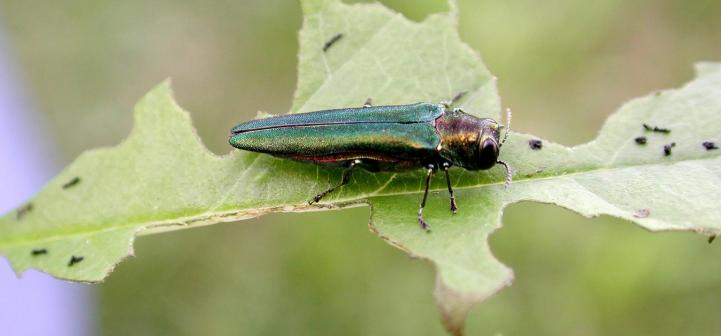Invasive Species: Centaurea jacea, Brown Knapweed
Brown knapweed is an invasive perennial plant that grows 1 to 3 ft (0.3 to 0.9 m) tall and invades dry fields, roadsides, and meadows. The basal leaves are oblanceolate to elliptic and 2 to 10 in. (5 to 25 cm) long. Leaves become smaller and more linear as they move up the stem. Flowering occurs from June to September, when magenta flowers appear in 1 to 1¼ in. (2.5 to 3.2 cm) wide, solitary heads at the tips of the branches. Brown knapweed produces small, light brown, plumeless seeds, about 12 per head. Brown knapweed is native to Europe.
What are invasive species and why should we be concerned about them?
Taxonomy: Scientific and Common Names for This Species
Asterales > Asteraceae > Centaurea jacea L.
Synonym(s): brown knapweed
Centaurea jacea – USDA PLANTS Profile
Distribution Maps
Brown knapweed – The reported distribution of this invasive species across the United States. (Source: Invasive Plant Atlas of the United States)
Up-to-the-minute distribution maps and why they are important.
Reporting This Invasive Species
What is the best way and place to report the occurrence of an invasive species?
How to report an invasive species sighting to EDDMapS – Early Detection & Distribution Mapping System
EDDMapS – Report an invasive species to EDDMapS
Cooperative Extension Offices – Find your local Cooperative Extension office on this map provided by USDA
How to Identify
This invasive species can be identified by looking for the characteristics described in the paragraphs that follow.
Plant
Brown knapweed is an invasive perennial plant that grows 1 to 3 ft (0.3 to 0.9 m) tall.
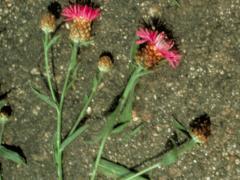 |
 |
| Cindy Roche, bugwood.org | Bruce Ackley, Ohio State University, bugwood.org |
Foliage
The basal leaves are oblanceolate to elliptic and 2 to 10 in. (5 to 25 cm) long. Leaves become smaller and more linear as they move up the stem.
 |
 |
| Bruce Ackley, Ohio State University, ugwood.org | Bruce Ackley, Ohio State University, bugwood.org |
Flower
Flowering occurs from June to September, when magenta flowers appear in 1 to 1¼ in. (2.5 to 3.2 cm) wide, solitary heads at the tips of the branches.
 |
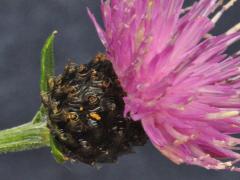 |
| Cindy Roche, bugwood.org | Bruce Ackley, Ohio State University, bugwood.org |
Fruit
Brown knapweed produces small, light brown, plumeless seeds, about 12 per head.
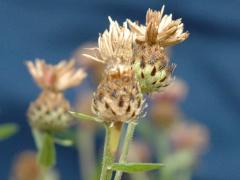 |
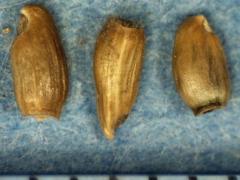 |
| Bruce Ackley, Ohio State University, bugwood.org | Bruce Ackley, Ohio State University, bugwood.org |
Native Centaurea Species That Resemble Brown Knapweed
Centaurea americana, American star-thistle – Images at invasive.org
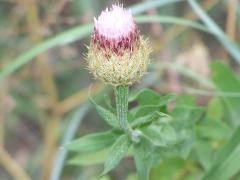 |
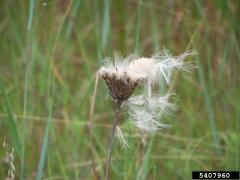 |
| Karan A. Rawlins, University of Georgia, bugwood.org | Karan A. Rawlins, University of Georgia, bugwood.org |
Vernonia gigantea, tall ironweed – Images at invasive.org
 |
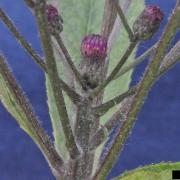 |
|
Bruce Ackley, The Ohio State University, |
Bruce Ackley, The Ohio State University, bugwood.org |
Additional Images for Brown Knapweed
Brown knapweed – Images at Invasive.org
Learning Resources for Brown Knapweed
Centaurea jacea Identification Card – US Fish & Wildlife Service
Centaurea jacea Fact Sheet – US Fish & Wildlife Service
Additional Information, Biology, Control and Management Resources
Control and management recommendations vary according to individual circumstances. Location, habitat, weather, and a variety of other conditions are factors that help determine the best treatment choice. To find the safest and most effective treatment for your situation, consult your state’s land-grant institution. If you will use chemicals as part of the control process, always refer to the product label.
United States Land-Grant University System – Find your land-grant university’s College of Agriculture, Cooperative Extension Service, or other related partner on this map provided by USDA.
Weed of the Week – USDA Forest Service
Centaurea jacea – Flora of North America
Connecticut Wildflowers – Connecticut Botanical Society
Centaurea jacea – BUGWOOD Wiki
Invasive.org – Center for Invasive Species and Ecosystem Health
Jepson Herbarium – University of California
